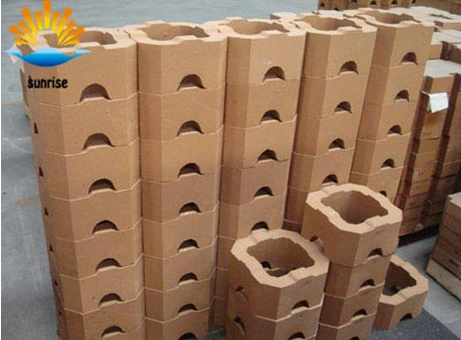Hot Product
Refractory Knowledge
The performance and usage of magnesia brick
Date:2016-07-14 01:44 From:Zhengzhou Sunrise Refractory Author:admin
1. Chemical composition and mineral composition
The chemical composition of magnesia brick due to the difference of magnesia material used. In the magnesia brick mineral composition, the main crystal is periclase , accounted for 80%
~ 90% of magnesia brick quality, The matrix compound for MF,MA, M2S, CMS, etc. Is composed of main crystal and matrix of eutectic compounds are: M - MF, M - MA, M - M2S, MF - M2S, MF
- CMS, MA - M2S, MA - CMS, CMS - M2S, etc. The eutectic compounds are composed of main cristal and matrix contain: M - MF, M - MA, M - M2S, MF - M2S, MF - CMS, MA - M2S, MA - CMS,
CMS - M2S, etc.
As the main crystal of magnesia brick is strong basic periclase, big density (3.5 g/3cm), less water, high molding pressure, low porosity (19%), bulk density (2.8 g/3cm). So, mineral
composition, strong alkalinity, high density is a significant characteristic in magnesia brick.
2. Refractoriness
The melting point of periclase is as high as 2800 ℃. So the refractoriness of magnesia brick is very high , generally can reach more than 2000 ℃.

3. The thermal conductivity and guide warm
Magnesia brick has good thermal conductivity, but significantly lower thermal conductivity increases with temperature. Due to the heat capacity of magnesia brick and bulk density are
large, Although thermal conductivity is large, guide warm is poor , the temperature changes relatively slowly. Good thermal conductivity and poor guide warm difference is another
significant feature of magnesia brick.
4. Thermal expansion and thermal shock resistance
The thermal expansion of magnesia brick is larger, and the linear expansion coefficient increases with temperature rise. The thermal shock stability of magnesia brick is poor, water-
cooled frequency is only 2 ~ 3 times. Because large thermal expansion coefficient, poor guide warm, the temperature leaps occurs easily produce larger thermal stress. Matrix of CMS
have anisotropy, when the temperature leaps, for the expansion difference and contributed to the thermal stress. Iron acid magnesium into and precipitation also leads to the generation
of internal stress. The elastic modulus of magnesia brick is higher, the stress of buffer capacity is weak. So easy expansion and split, that is large heat dilatability and poor thermal shock
resistance .
The chemical composition of magnesia brick due to the difference of magnesia material used. In the magnesia brick mineral composition, the main crystal is periclase , accounted for 80%
~ 90% of magnesia brick quality, The matrix compound for MF,MA, M2S, CMS, etc. Is composed of main crystal and matrix of eutectic compounds are: M - MF, M - MA, M - M2S, MF - M2S, MF
- CMS, MA - M2S, MA - CMS, CMS - M2S, etc. The eutectic compounds are composed of main cristal and matrix contain: M - MF, M - MA, M - M2S, MF - M2S, MF - CMS, MA - M2S, MA - CMS,
CMS - M2S, etc.
As the main crystal of magnesia brick is strong basic periclase, big density (3.5 g/3cm), less water, high molding pressure, low porosity (19%), bulk density (2.8 g/3cm). So, mineral
composition, strong alkalinity, high density is a significant characteristic in magnesia brick.
2. Refractoriness
The melting point of periclase is as high as 2800 ℃. So the refractoriness of magnesia brick is very high , generally can reach more than 2000 ℃.

3. The thermal conductivity and guide warm
Magnesia brick has good thermal conductivity, but significantly lower thermal conductivity increases with temperature. Due to the heat capacity of magnesia brick and bulk density are
large, Although thermal conductivity is large, guide warm is poor , the temperature changes relatively slowly. Good thermal conductivity and poor guide warm difference is another
significant feature of magnesia brick.
4. Thermal expansion and thermal shock resistance
The thermal expansion of magnesia brick is larger, and the linear expansion coefficient increases with temperature rise. The thermal shock stability of magnesia brick is poor, water-
cooled frequency is only 2 ~ 3 times. Because large thermal expansion coefficient, poor guide warm, the temperature leaps occurs easily produce larger thermal stress. Matrix of CMS
have anisotropy, when the temperature leaps, for the expansion difference and contributed to the thermal stress. Iron acid magnesium into and precipitation also leads to the generation
of internal stress. The elastic modulus of magnesia brick is higher, the stress of buffer capacity is weak. So easy expansion and split, that is large heat dilatability and poor thermal shock
resistance .
Inquiry:
If you have any questions or good suggestions on our products and site, or if you want to know more information about our products, please write them and send to us, a representative will contact you within one business day. We guarantee that your information will not be divulged to the third party.

